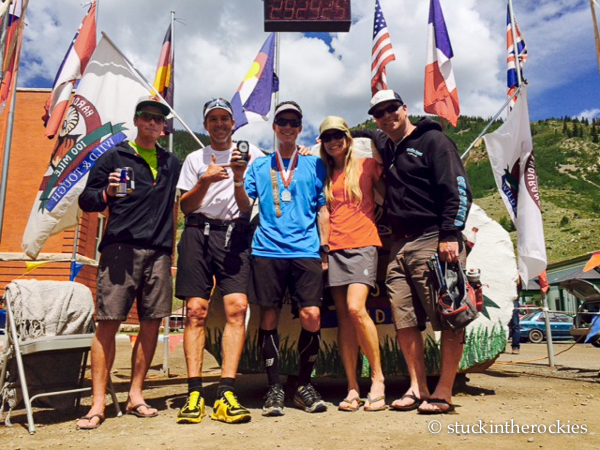
Pete, Dav, Christy, and Tim at the finish. Thanks guys!
The 2014 Hardrock 100 was last weekend.
When I kissed the rock the clock read 29:23, which was good for tenth place. It was my fifth top-ten finish at this race in as many years, and this year had the most competitive mens field the race has likely ever seen.
Any finish at the Hardrock 100 should be considered a great achievement. There are so many ways to come up short on the burly course that anyone who makes it all the way back to Silverton deserves to be commended. Going sub-30 hours is something to be psyched about. I was a little slower compared to the prior two years but it was also said that conditions were harder. I want to say thank you to everyone who offered encouragement before and congratulations after, and I particularly need to thank my support and pacer crew there- Christy, Tim Mutrie, Pete Gaston, and Chris Davenport. It was a huge effort and they deserve credit for my final result.
And that’s the short version of how it went.
The simplified numbers of the overall results don’t tell the whole story though. There are countless details that go into anyone’s finish at this race, and rare is it that everything gets executed flawlessly. This race requires such a massive effort, not just in a physical sense, but mentally and even emotionally, that it might be weeks or months before my own mind fully processes it all. So here’s my longer version of how things went down.
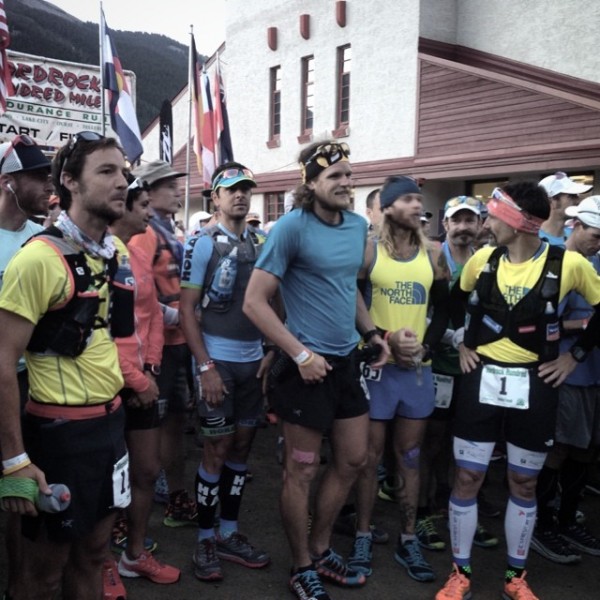
The start. I’m far to the right playing with my watch as the soon-to-be-leaders try to play it cool.
(Mauricio Herrera Cuadra Photo)
It was definitely the most competitive front end the men’s race had ever seen, with six top level pros including the now undisputed top mountain runner in the world, Kilian Jornet. Even though I tend to finish well regardless of who is in the race, I was convinced that a top ten finish wasn’t likely this year.
These guys would be going out in pursuit of record time, and I knew I didn’t stand a chance of keeping up. But since it might be my only opportunity to start alongside elites like Kilian, I thought it would be fun to line up right in front with them. I cruised with the leaders, some of the best in the world, before slowing down and settling into my standard casual pace, right around the Mineral Creek Crossing. That was fun.
If one thing stood out as being the most challenging variable it was that the course was very wet. Lingering snow, soggy trails, high creeks, and eventual rain prevented anything from drying out much. My feet were wet from the first creek crossing all the way through to the finish. That can eventually become a problem on a long course such as this one. And the mud and snow also contributed to a couple of spectacular wipeouts—I found myself down on my ass a few different times in slippery mud, I took an impressive slide down the snow of Virginius Pass, and though it wasn’t water-related, I took a digger going down on the scree of Grant-Swamp Pass.
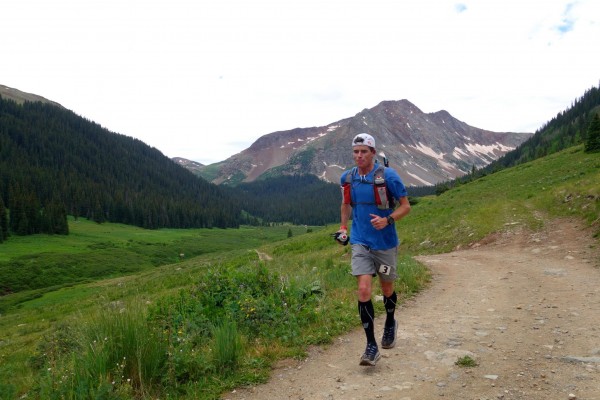
After the first two passes, approaching the KT aid station. (Irunfar.com Photo)
I tried to stay comfortable pace-wise through the early legs, but I often felt like I was going too hard. I regularly reminded myself to slow down, it was going to be a long day. It was overcast but really humid, and through most of the day I was sweating way more than I’m usually comfortable with. I did a good job of finishing a bottle of fluids per hour minimum, and I was peeing regularly if not often, but it still felt like I was bordering on dehydration. Afterwards I talked to several racers who commented on how the heat affected them, primarily by causing some GI distress which tends to hang around once it gets established.
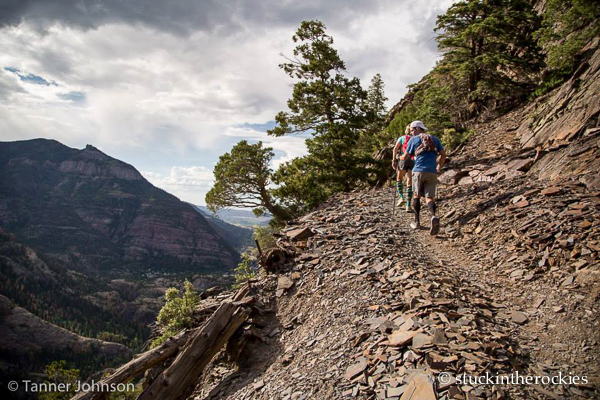
Heading up the switchbacks of Bear Creek with Christy. (Tanner Johnson photo)
Despite those details, all of which are really just ordinary issues out there, I pared about five minutes off every major aid station through the day, and arrived in Ouray at 4:41pm, 23 minutes ahead of my 2012 race (28:20). My initial top goal (I always set a few tiers of goals, one of which is simply to finish) was to go sub 28 hours, which would have required a 20+ minute PR, and I was looking to be right on pace. I think I was around 18th place overall, a somewhat typical place for me to be at that point.
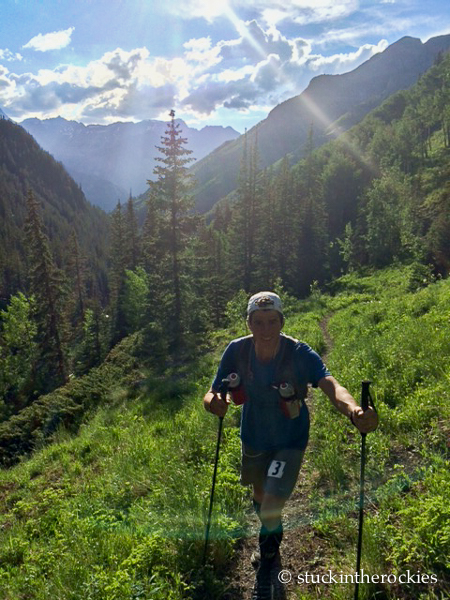
Heading up Bear Creek towards Engineer. So far so good.
After a second sock change, I left Ouray with Christy as a pacer. I was feeling good. When we got to the top of the Bear Creek switchbacks we jogged by U.S. race favorite Timmy Olson walking the trail, the first casualty of the heat and pace. I was starting to feel as though the back end of the race would once again be good to me. Soon after that, we passed a limping Joe Grant, another American front-runner who told us he had some sort of muscle injury. Strange things happen at this point in the race, and I knew it was likely we would encounter more front runner carnage ahead.
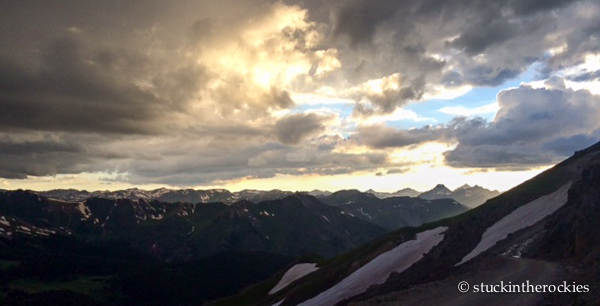
Looking to the west from Engineer Pass.
As Christy and I made our way over Engineer Pass, we headed down to Grouse Gulch, and it was looking like we would get there without needing headlamps. That would be a first for me, and it meant I was still on PR pace. As we descended to the aid station, a stunning sunset developed. There was some mist in the air and lot of clouds, and the red hue lit up the green grassy slopes, interspersed with patches of summer snow. A double rainbow appeared overhead. We saw there was some weather just over the mountain, but we figured we would be out of its way by the time it arrived. And just as quickly we were talking about how pretty it all was, the thunder boomed and the rain started coming down.
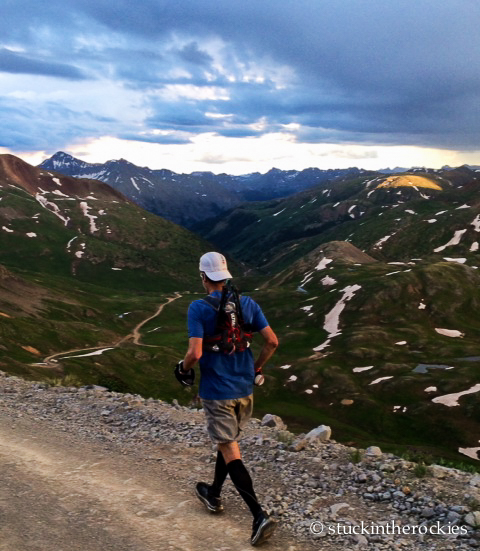
Grouse was down in the valley below. Just before the rain, around mile 55, and everything was good.
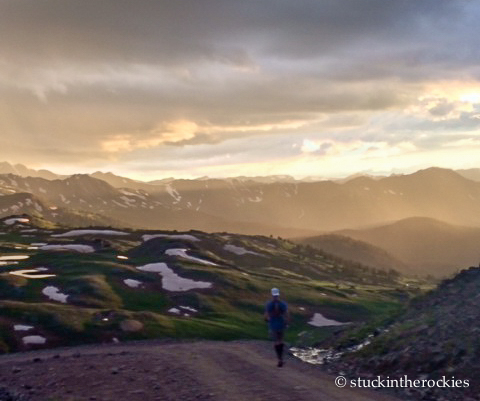
The misty sunset.
We were 15 minutes out from Grouse and we were thoroughly soaked. Lightning and thunder was all around and even though we were down in the valley floor, it was still concerning. I felt bad for the leaders who were partway up the next leg, the 14er Handies Peak. We saw repeated lightning strikes up high, including one that hit neighboring American Peak, and were glad we weren’t up there. We pulled into Grouse aid station as it got dark and Pete, Dav, and Tim had a spot all ready for me in the tent. I sat down and started to change my clothes and realized I sitting next to Seb Chaigneau, last year’s winner from France. He was being tended to by his crew members, and he was reportedly unable to move his legs. His race was done.
I changed into dry clothes, and grabbed a dry rainshell. I switched my hat and sunglasses for a buff, sleeves, and my lights, and reluctantly headed out into the rain with Pete Gaston to head up Handies Peak. These storms usually don’t last long, and this one was on its way out. The rain let up as we made our way up from the aid station and we focused on the task at hand— getting over the 14,048 foot summit, the high point of the course. Up ahead the lightning and thunder seemed to be hanging around though, with occasional strikes on the ridge, and we both silently hoped it would move on by the time we were nearing the summit. Some lights were coming down the trail towards us, and as they approached they stepped off to the side to allow us by and I heard a familiar voice wish us good luck. It was Dakota Jones. He had injured his ankle and was done. Four of the six favorites had now bowed out.
Pete and I continued up, and got over summit of Handies around 11:30pm, during a break in the weather. It appeared that a wall of clouds was coming in behind us, but it was dark and we were unsure. As we began down the other side a couple sets of headlamps were ahead, and it started sprinkling again. We caught up to Darcy and her pacer Gavin, and the rain got heavier. We took off ahead of them in what was now a building deluge, the trail had become a small flowing creek, and we were once again soaked through. After 20-30 minutes we were at the bottom, at the Burrows Park aid station. Pete and I jumped into the tent, drenched. I saw Jason Koop inside and remarked on the weather. He didn’t respond, and then walked out of the tent and actually got into a car. I took that as his race being done. We left and ran down the road for four miles to the Sherman aid station, at mile 72.
It was around 1am and it was still raining. Even though this second wave of rain wasn’t showing any signs of letting up, we were thankful that it didn’t have any lightning. But steady rain without lightning is often an indicator of a larger storm rather than a small passing cell, and that was disconcerting. I didn’t want to be in the rain all night. As we made our way down the shelf road, I became preoccupied with the thought that next crew aid station (with dry clothes) after Sherman would be Cunningham, almost 20 miles and seven hours away. Most of that stretch would be in the dark before the sun rose, through the back half of the night when the temperatures are lowest, late night fatigue is highest, and mental acuity is dull.
Even though we were moving up in the field, all I could think about was being out in the darkest part of the night soaking wet and exposed. It’s pretty cold on the high passes at 5am, and after 23 hours, you’re low on energy and not moving quick. It doesn’t take much to find yourself hypothermic. I shared my concerns with Pete, and as we arrived to the tents of Sherman Aid Station, we got out of the rain and sat down. And as I look back in hindsight, that was when my “race” came to an end.
There was never talk of quitting, I was fully able to go on, but the rain and conditions had managed to extinguish any competitive fire. I went from feeling psyched to indifferent. I once again changed out of my wet clothes— head to toe, and my socks for the 4th time— and had a seat and watched the rain. Four guys were in front of me on the trail, close enough to be reeled during any other year I’ve been here, but I just sat there and let them get away. I wouldn’t see any of them again.
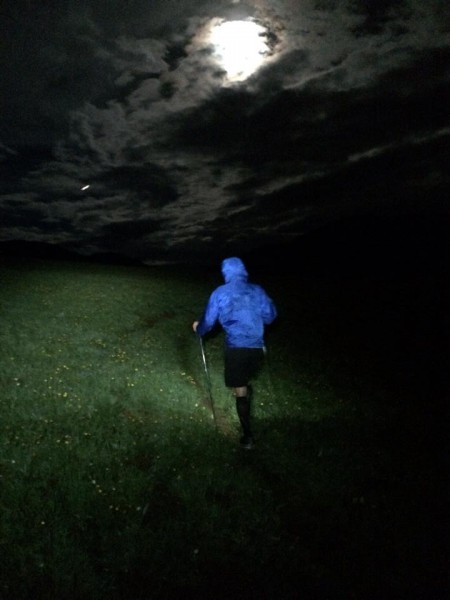
Late Friday night, high in Cataract Creek as the clouds broke.
Pete and I eventually left Sherman after a 25 minute break and made reasonable time to Cunningham, mile 91, where Dav tagged in and took me to the finish. Even though the rain stopped soon after leaving Sherman (around 3am), everything on the course was still wet. A full day in wet shoes and socks can leave your feet in pretty bad shape, and it was painful to run. When we neared town, everything felt OK as it always does, and I was really happy to wrap it up and finish where I did.
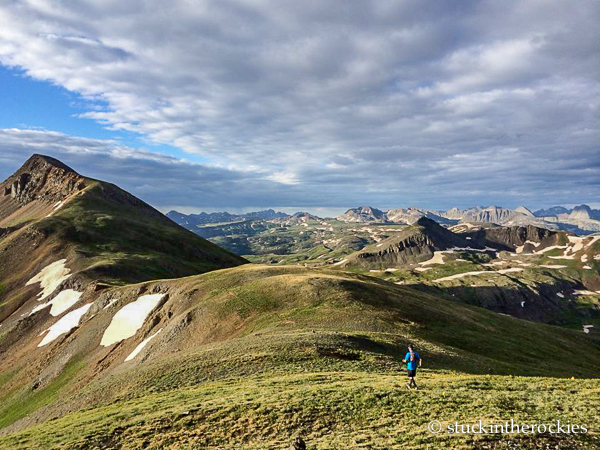
Between Maggie and Cunningham, Saturday morning.
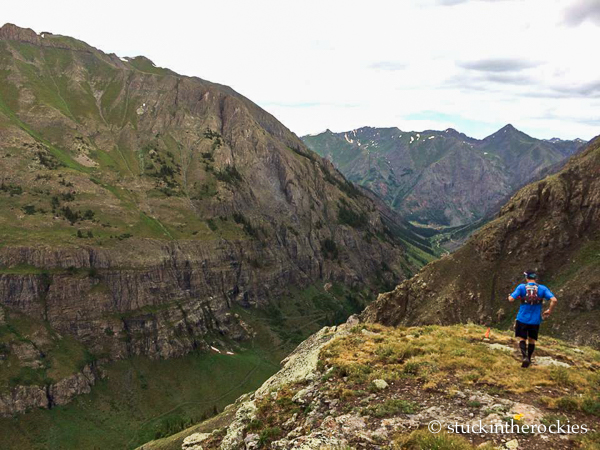
The descent to Cunningham, mile 91, is so steep you can’t even see the valley floor until you’re all the way down. From there, Chris Davenport took me up and over the other side, known as Dives/Little Giant Pass, and to the finish.
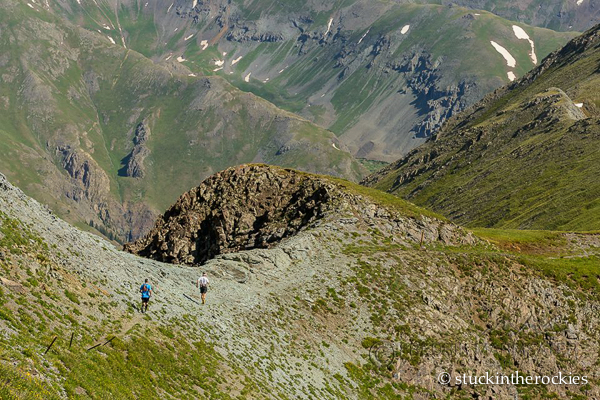
Fred Marmsater took this shot of Dav and I traversing to the final descent to the finish. This is Dives/Little Giant Pass.
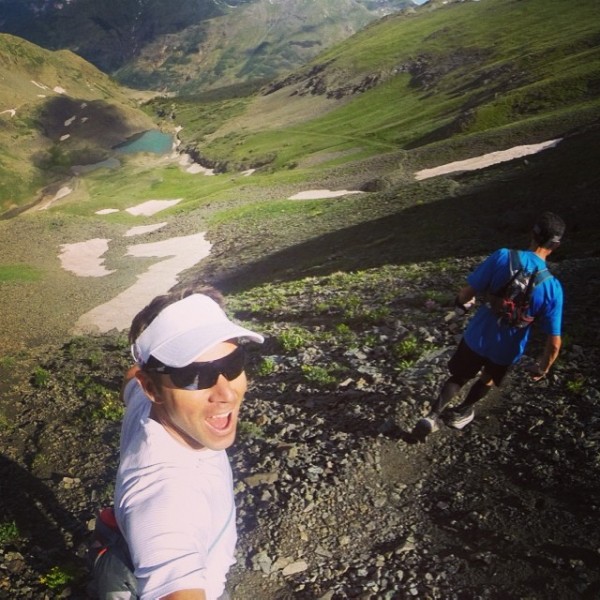
On that last leg, in between selfies, Dav was employing some serious drill sergeant pacer tactics.
Here are my times to each aid station and how they measured against my 2012 PR. Notice the clear tempo change with the arrival of the rain:
KT 8:44 (-4 minutes compared to 2012)
Chapman 10:30 (-14)
Telluride 1:00 (-25)
Virginius 2:55 (-23)
Governor 3:28 (-26)
Ouray 4:41 (-23)
Engineer 7:13 (-22)
Grouse 8:56 (-20)
Sherman 1:14a (-2)
Pole Creek 4:46a (+33)
Maggie 6:21a (+37)
Cunningham 8:33a (+47)
Finish 11:23a (+63)
I spent 55 minutes in total at aid stations. Only eleven of those minutes were used through the first 52 miles (through Engineer). I spent 32 minutes at Grouse and Sherman.
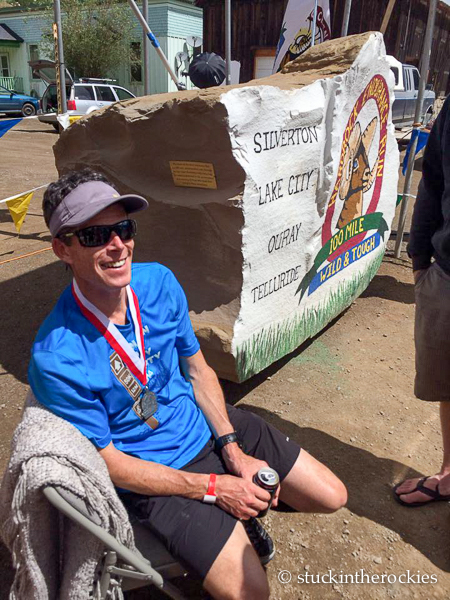
Finish #7 complete, I hung on to top-ten for the 5th year in a row and nabbed another solid sub-30 hour time. I’m pretty happy with that especially considering how I allowed things to go towards the end.
It was my 3rd fastest time, about an hour behind 2012 and 2013. After six consecutive years of improvement, this was the first year I was slower.
Everyone said the conditions were tougher. I agree with that, specifically the weather, but I have to attribute my effort to other things as well.
I always tell people this race and other similar big efforts are as much mental as they are physical— mind over matter. You can’t just say you want to do it. You have to truly believe you can. If there’s ever self-doubt, things fall apart. And this year confirmed that notion. As I mentioned at the beginning, it was still a great day, certainly a memorable one. I always ask myself what I’ve learned after any big endeavor. There should be something to take away and apply in the future. In this case, keep your head in the right place and don’t lose focus and everything else should fall in line.
And that’s why I think I keep going back, to hopefully get that elusive day where everything falls into line. Maybe that will be next year?

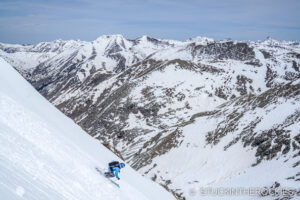
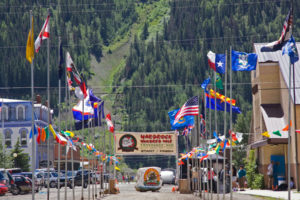
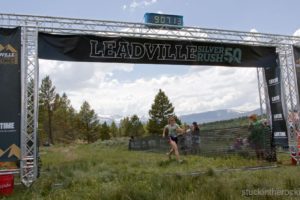
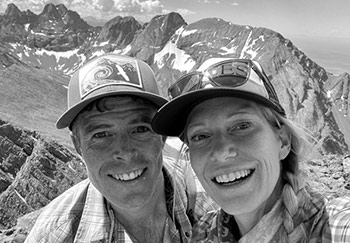





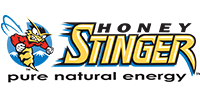
13 Comments
Leave your reply.